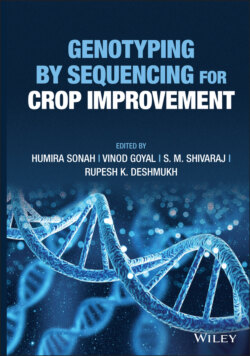Читать книгу Genotyping by Sequencing for Crop Improvement - Группа авторов - Страница 11
Preface
ОглавлениеRecent advances in sequencing technology and computational resources have accelerated genomics and translational research in crop science. The technological advances have provided many opportunities in genomics‐assisted plant breeding to address issues related to food security. Among the several applications, genotyping‐by‐sequencing (GBS) technology has evolved as one of the frontier areas facilitating high‐throughput plant genotyping. The GBS approaches have proved effective for the utilization in genotyping‐based applications like quantitative trait loci (QTL) mapping, genome‐wide association study (GWAS), genomic selection (GS), and marker‐assisted breeding (MAB). Considering the current affairs in plant breeding, we decided to compile the advances in GBS methods, statistical approaches to analyze the GBS data, and its applications including QTL mapping, GWAS, and GS in crop improvement.
Presently, the food produced around the world is adequate for the existing population. However, the constantly increasing population mounting pressure on a food production system. Hence efficient utilization of technological advances and existing knowledge is essential to enhance food production to match the growing food demand. In this direction, most of the countries around the globe have adopted advanced genomic methodologies to breed superior plant genotypes. Among such technological advances, the high‐throughput genotyping using GBS has shown promising results in different crop plants. The GBS has predominantly been used for germplasm evaluation, evolutionary studies, development of dense linkage map, QTL mapping, GWAS, GS, and MAB. The cost‐effectiveness and whole‐genome coverage make GBS more reliable than other next‐generation sequencing (NGS) techniques.
This book describes advanced molecular markers, high‐throughput genotyping platforms, whole‐genome resequencing (WGR), QTL mapping using advanced mapping populations, analytical pipelines for the GBS analysis, advances in GWAS, advances in GS, application of GBS, GWAS, and GS in different crop plants. The different marker types including traditional and advanced markers used in plant genotyping have been presented in great detail. DNA extraction directly from seeds without germination can save time and effort. Several modified and crop‐specific nondestructive seed DNA extraction protocols have been compiled and presented. Many advanced genotyping platforms are now available which cater to specific research purposes because of the differences in terms of reaction chemistry involved, cost, method of signal detection, and flexibility in the protocols. Such advanced platforms along with their principles have been discussed. The WGR methodology and available resources have been covered in detail. The WGR has emerged as a powerful method to identify genetic variation among individuals. The recent advancement in WGR includes pool‐Seq which provides an alternative to individual sequencing and a cost‐effective method for GWAS. Compared to biparental populations the multi‐parental population provides an opportunity to interrogate multiple alleles and to provide an increased level of recombination and mapping resolution of QTLs. The use of such improved populations in the era of high‐throughput genotyping has been presented in one of the chapters. The dedicated section focused on the basic principle of GWAS, the efficiency of different markers, candidate gene identification, meta‐GWAS, and statistical methods involved in GWAS analysis has been included. For genetic mapping, and marker‐assisted selection, rapid and quality DNA isolation is mandatory to accelerate the whole process. A focused section about GS has been included which gives an account of the basic concept, advances, applicability, and challenges of GS. Similarly, a separate chapter is included which discusses the analytical pipelines used for GBS data. Application of technologies such as GBS, GWAS, and GS in different crop categories like cereals, pulses, oilseeds, and commercial crops has been discussed in different chapters.
Here, we have tried to compile basic aspects and recent advances in GBS, GWAS, and GS in plant breeding. We believe that the book will be helpful to researchers and scientists to understand and plan future experiments. This book will enable plant scientists to explore GBS application more efficiently for basic research as well as applied aspects in various crops improvement projects.
Editors
Dr. Humira Sonah
Dr. Vinod Goyal
Dr. S. M. ShivarajDr. R. K. Deshmukh
